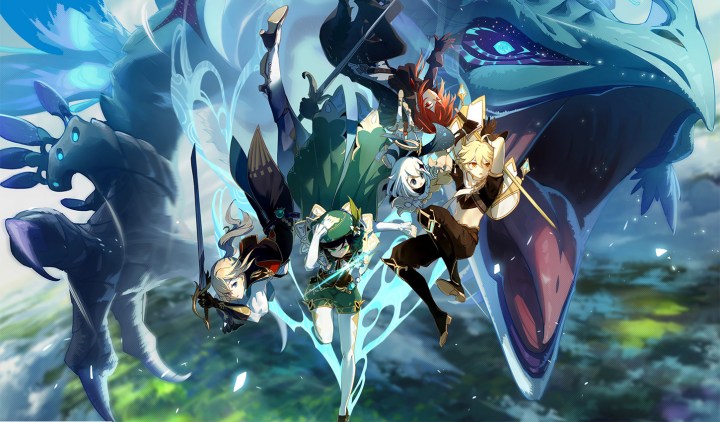The way that games are played and experienced is rapidly changing across the globe. Instead of making games that are designed to be played for a limited period of time and then discarded for the next one, developers have increasingly leaned into games that are updated frequently over the course of several years.
These “live games”, also frequently known as “games as service,” concentrate on building their player base over time with enticing new content releases and balance updates rather than aiming for the usual gigantic day one audience. While some games have been criticized for slights like oppressive microtransactions and undesirable content, others have built incredible experiences and demonstrated constant dedication to their fans.
Here are the Digital Trends team’s picks for the best live service games of 2021.
Apex Legends

Apex Legends has undergone quite the evolution this past year (how appropriate that its most recent past season was actually called Evolution). The game has gone from being one of many online battle royales to a standout experience thanks to new characters like Ash, whose lore connects Apex to the events of Titanfall more deeply than ever. The gameplay itself also got a big update in 2021 with the addition of Arenas, which brings smaller Valorant-style matches to the game.
Beyond the new legends and mode, developer Respawn demonstrated its commitment to the game with a new battle royale map in Storm Point, several smaller new maps for Arenas, new weapons — including the all-new bow and a new ammo category — and several events each season with their own cosmetics and unlockable items.
Nothing quite compares to the excitement of opening up a new season’s battle pass and checking out what new skins and goodies you’ll be able to obtain over the next few months. Though the game has hit some rough patches this year with extended server troubles and connection issues, that’s simply a testament to how many people want to play the game at once. In 2021, Apex Legends proved it will be a battle royale juggernaut for many years to come. ~ Emily Morrow
Final Fantasy XIV

Up until the belated release of Endwalker last week, Final Fantasy XIV was in the midst of its slowest year of content releases yet. But that didn’t stop it from finally hitting it big, with a devoted community ready and waiting to welcome an influx of new players finally ready to leave their old game behind.
Between the fights, the farming, and the crafting, the denizens of Eorzea and beyond have always made their own content. They’ve turned player housing not only into a planning and designing business opportunity, but into cabaret clubs, theaters, makeshift concerts, and safe havens for people to safely express and be themselves. They’ve created viral videos and comedic personas like Mr. Face, and even once made magazines to highlight the craftsmanship of its community.
Even during its droughts, Final Fantasy XIV has laid the foundations for its players to make their own fun in the absence of big updates. Between the typical endgame content farm of any MMO, there’s chocobo breeding and racing, card tournaments, tiny minion MOBAs, dangerous dungeon crawls, meme-fueled classes like Blue Mage, and expeditions into places like Eureka that turn the typical rules of combat on its head.
And then, at the end of it, there’s just a deep-rooted appreciation for looking good — so much so that there’s an official magazine dedicated to how players dress their avatars. In a year that’s seen big tech trying to hype up their version of the metaverse, we all know gaming has had them for decades — and Final Fantasy XIV continues to be one of the finest. ~ Josh Brown
Animal Crossing: New Horizons

It’s been a weird year for Animal Crossing: New Horizons. The cozy life simulator was all the rage when it was released in 2020 due to its launch lining up with social lockdowns. Nintendo had a major hit on its hands and it was in a great position to push the momentum with post-launch content. That didn’t quite happen as players hoped. The game got a slow trickle of updates that especially slowed once holidays began to repeat. For most of 2021, New Horizons had failed as a live service game.
Fortunately, the game got a major update in November that added tons of content to the game. Its 2.0 update brought several new features that convinced me to return to my island. But New Horizons’ real secret weapon proved to be its paid DLC. Happy Home Paradise is a fantastic addition to the game and a must-own for Animal Crossing players looking to expand the game’s life span. The design-focused side game is one of the most pleasurable things I’ve done in New Horizons and has totally made me rethink how I decorate. While 2.0 isn’t likely to hold my interest long-term, Happy Home Paradise is the exact excuse I’ve needed to log back in. ~ Giovanni Colantonio
Call of Duty: Warzone

Call of Duty: Warzone is a game full of little memorable moments. Moments like being one of the last teams alive, making an expertly planned play, or even something as simple as an effective call-out all come to mind. The odds are unequivocally stacked against you, but that’s precisely why it feels so good to come out on top. Warzone is challenging and complex, with an overwhelming number of weapons and attachments to choose from, each with different stats and quirks. This gives players no shortage of things to unlock and master, with an underlying sense of experimentation and variation always at the forefront.
In 2021, developer Raven Software won back the community when it finally doubled down on fixing the game’s greatest issues, while also offering more communication with its player base. This turn was one of the shining moments in Warzone’s life cycle, pointing to a bright future with Raven behind the wheel. It isn’t the easiest game to get into, especially with its overabundance of unlockables and complicated mechanics, but once it clicks, Warzone is immensely fun — and there isn’t anything quite like it. ~ Joseph Yaden
Genshin Impact

Genshin Impact started as a so-called “Breath of the Wild clone” but evolved into something greater. Players realized that its complex combat system, lovable cast of characters, and gacha mechanic fundamentally set it apart from its inspiration.
Developer Mihoyo built far beyond the game’s initial setup from September 2020. Over 15 characters joined the roster in the past year, including outsider Aloy from Horizon Forbidden West. Mihoyo also introduced regions such as Dragonspine and Inazuma, and celebrated these additions with special events to engage its passionate community of players.
Players can endlessly explore the continents, experiment with characters and equipment, and even build a hideout inside a pocket teapot. Simple additions like fishing holes have also expanded the possible adventures a player can have in Teyvat. It feels like there’s always something to do (though max level players might beg to differ).
Genshin Impact continues to be an entertaining experience for casual and hardcore players despite its grind-heavy gameplay and questionable PR stunts (like the Elon Musk fiasco). I agree that it takes some heavy investment to really enjoy the game to its fullest. However, once you get there, the view is beautiful. ~ Jess Reyes



